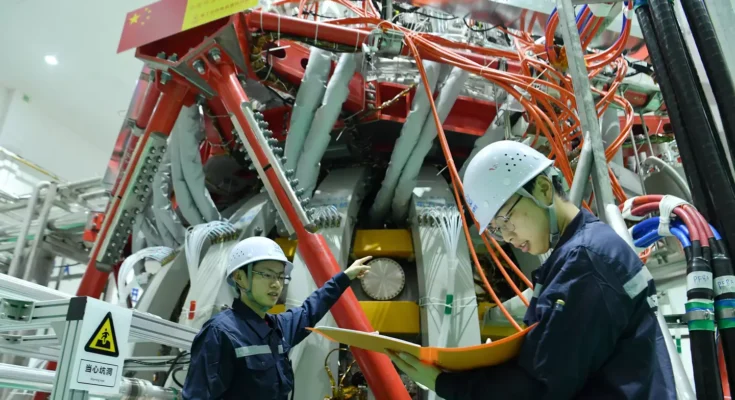Scientists may have just taken one step closer to bringing the world unlimited clean renewable energy.
Scientists in China say they have exceeded their expectations and achieved a new milestone after an energy test.
The researchers have attempting to create a viable power generation through nuclear fusion and it has been deemed the ‘holy grail’ for clean energy.
The Chinese Academy of Sciences (CAS) has said that is nuclear reactor, dubbed the ‘artificial sun’, successfully ran twice as long as their previous test. It ran for 1,066 seconds, just over 17 minutes.
The idea of replicating the Sun’s nuclear fusion process hasn’t just been relegated to science fiction as scientists around the world have experimented continuously to make it a reality.

The successful experiment is said to be an important step forward (Zhang Yazi/China News Service/VCG via Getty Images)
Mastering this process could provide humanity with a limitless clean energy source. An artificial sun reactor has the possibility to avoid the pitfalls of other energy sources, as it would not produce the emissions like fossil fuels, or leave behind any hazardous waste like that seen from the fission process in nuclear power plants.
A nuclear fusion reactor would merge atomic nuclei, generating massive amounts of energy in the process that can be turned into electricity.
In a statement CAS said that its reactor, the Experimental Advanced Superconducting Tokamak (East) smashed the previous operating time of only 403 seconds.
The statement said: “The duration of 1,066 seconds is a critical advancement in fusion research.”
The quest for this perfect energy source isn’t without its hurdles, however.
Researchers must find a viable way to ensure the reactor can consistently reach temperatures exceeding 100 million degrees Celsius, while maintaining stable long term operation. As well as this, scientists will need to have precise control over the nuclear fusion process.

Scientists analysing the results from their latest artificial sun test (Zhang Dagang/VCG via Getty Images)
The vice president at CAS’s Hefei Institutes of Physical Science Song Yuntao said to enable the self-sustaining circulation of the fourth state of matter, plasma, a fusion device must achieve ‘stable operation at high efficiency for thousands of seconds’.
This new milestone was able to be achieved thanks to upgrades to East since the last round of experiments. Most notably scientists doubled the power output of the heating system.
These achievements, according to researchers, provide ‘invaluable insights’ and references for the global development of a functional nuclear fusion reactor.
Only time will tell if we are still complaining about energy prices in the next couple decades.

One of humanity’s largest ever projects is slowing down the spin of the Earth, making our days slightly longer.
Work on China’s Three Gorges Dam, the largest power station in the world, wrapped up in 2006. Located on the Yangtze River, just west of the city of Yichang in Hubei province, the project took 17 years and cost $37 billion to construct.
The purpose of the Three Gorges Dam

The Three Gorges Dam is the world’s largest hydro dam (VCG/VCG via Getty Images)
The hydro dam now generates around 0.54 Twh of electricity a day, enough to power 5.4 million households for one month.
Not only does it power communities, but the Chinese government said Three Gorges was essential to stop continuous devastating floods across lower lying lands.
However, some 1.5 million locals were forced to leave their homes as 13 cities and 140 towns in the country were flooded for the project to become a reality. And now, the country has proposed an even larger hydro dam across the Yarlung Zangbo River which could be three times as powerful as the Three Gorges.
This has worried environment experts; especially when you consider the impact Three Gorges has already had on our planet…
NASA’s worry over Three Gorges Dam

The Three Gorges Dam took 17 years to build (Costfoto/NurPhoto via Getty Images)
The US space agency was concerned about a number of factors, including disease, pollution, landslides and seismic activity issues.
NASA explained on its Earth Observatory website: “The epic scale of the dam project is matched by the level of controversy it continues to generate.
“Concerns about major environmental impacts, the relocation of 1.2 million people, and the flooding of 13 cities, more than 1300 villages, archeological locations, and hazardous waste dumps were raised throughout the planning and implementation.
“Environmental concerns include increased seismicity from the loading of the water, landslides, changed ecosystems, accumulated pollution, increased chances for waterborne diseases, and salinity changes in the Yangtze estuary.”
As if that wasn’t enough, the dam has also impacted the rotation of the Earth as it travels through the universe.
NASA explained that major changes to where mass lies on Earth can have small influences how our planet spins – known as its inertia.
How the dam slowed the Earth’s spin

The power of the dam is making our days slightly longer (DrPixel/NASA/Getty Images)
Dr Benjamin Fong Chao, a geophysicist at NASA’s Goddard Space Flight Center, explained that the giant dam has a capacity of 40 cubic kilometres.
That’s the equivalent of 10 trillion gallons of water – similar to the amount of mass that was shifted in the 2004 Indian Ocean earthquake and tsunami, which registered at 9.1 on the Richter scale.
NASA said that that earthquake decreased the length of day by 2.68 microseconds.
In contrast to that, the space agency states that when the Three Gorges Dam is at its fullest point, it actually creates a really small resistance to Earth’s spin – making the day longer.
Dr Chao’s own calculations say it would increase the length of a day by 0.06 microseconds as well as move the pole position of Earth by roughly two centimetres.
While these changes might be marginal – and can be triggered by natural disasters – surely it serves as a warning to be careful what we do on our planet…

China has approved a $137,000,000,000 project to build the most powerful hydro dam – but the move has left people concerned.
Human rights activists and environmentalists are worried construction of the world’s biggest mega project could have some serious consequences – especially as it’s being built on an ‘earthquake zone’.
Plans for the dam were first drawn up in 2020, almost 15 years after the current biggest dam – the Three Gorges in central China – was built.
Situated on the Yangtze River, Three Gorges is reported to generate 0.54 Twh electricity a day and can handle inflows of around 98.8m litres per second.

The Three Gorges Dam in central China (STR/AFP via Getty Images)
What is the new project?
The new dam will be located in the lower reaches of the Yarlung Zangbo River and could generate three times more electricity than that.
According to a 2020 estimate by Power Construction Corp of China, the new hydro dam could produce 300 billion kilowatt-hours of electricity annually.
Chinese state media says the project is a ‘safe project prioritising ecological protection, as per the BBC.
Despite its hefty financial cost, the dam will contribute to Beijing’s ‘climate neutrality goals’.

Construction will take place at the Yarlung Tsangpo River in Tibet, China (Photo by Li Lin/China News Service/VCG via Getty Images)
Why are experts so concerned?
There are a number of issues plaguing the expensive Yarlung Zangbo dam project.
The feat may require at least four 20 km-long tunnels to be drilled through the Namcha Barwa mountain, meaning the flow of the Tibetan river will be diverted.
For neighboring India – and Bangladesh, which the river also passes through – this could spell trouble, as interference with the water flow could trigger flash foods or even see the country face droughts.
Experts also feared that the dam would ‘empower China to control or divert the flow’ of the Yarlung Tsangpo River, which measures 1,125km in length.
A 2020 report published by the Lowy Institute said that ‘control over these rivers [in the Tibetan Plateau] effectively gives China a chokehold on India’s economy’.
The dam is also set to be located along a tectonic plate boundary prone to earthquakes. Researchers are worried drilling into the Namcha Barwa mountain and the continued construction of the dam may also increase the frequency of landslides.
Finally, the construction of the dam could displace locals, although it’s not known how many people the project would be forced to relocate.
However, Chinese authorities have stressed that the project would not have a major environmental impact.
Should construction go ahead, the dam is set to take 35 years to complete – that’s not until 2060.

China has just cost the US around $34,000,000,000 every decade after making a major rare mineral decision.
The country has banned all shipments of gallium and germanium, among other materials, to the United States.
The Chinese Commerce Ministry declared earlier this week: “In principle, the export of gallium, germanium, antimony, and superhard materials to the United States shall not be permitted,” citing ‘national security’ concerns as a reason for the ban.
The move continues to escalate tensions between the two countries as China attempts to counter US policies that curb Chinese tech advancements.

China produces the most of the world’s largest producers of gallium and germanium (Pla2na/Getty Images)
China are world-leading producers of these materials, accounting for 94 per cent of gallium and 83 per cent of germanium globally.
Russia is the second-largest producer of gallium.
Antimony will also be banned, while the export of graphite will now be subject to greater scrutiny.
Why are gallium and germanium important?
Gallium and germanium are primarily used in semiconductors – the tiny components help power almost all our modern-day electronics, including smartphones and computers.
Germanium is also used for fiber optic cables, solar cells and infrared technology, while antimony is a key material in bullet manufacturing and other weaponry.
Atimony, meanwhile, helps to harden alloys for use in lead–acid batteries, which are used in emergency lighting and electrical vehicle batteries.

Electric vehicle production could be impacted by the ban (Morris MacMatzen/Getty Images)
Graphite could also be affected, which is a major component in electric vehicle batteries.
Reduced access to these materials could slow down production, increase costs and disrupt supply chains.
What impact will China’s ban have on the US?
A report earlier this year from the US Geological Survey projected the impact China banning both gallium and germanium at once could have on the on the US’ gross domestic product.
That’s the measure of the size and health of a country’s economy over a period of time – usually a year.
The results indicated that a complete restriction of China’s net exports of gallium and germanium simultaneously could cause the US GDP to decrease $3.4 billion a year.
.jpg)
Germanium is mainly used in semiconductors (CorbalanStudios/Getty Images)
That works out at a $34 billion loss over the course of a decade, dealing a pretty big blow to the country’s economy.
And that’s just measuring the ban on gallium and germanium – the figure could be even larger taking antimony and superhard materials into account.
Nedal Nassar, lead author of Quantifying Potential Effects of China’s Gallium and Germanium Export Restrictions on the U.S. Economy, said of the model: “We do account for currently available production capacity outside of China and the short-term substitution potential. Our model projects the impacts in the near term and in many cases developing new supply sources or substitute materials takes far longer.”
Did you know a sinkhole in Asia plays host to a lush, ancient forest where trees tower nearly 130 feet tall?
Two years ago, scientists in Southwestern China discovered life was teaming inside a gigantic sinkhole, situated in the Leye-Fengshan Global Geopark in the Guangxi Zhuang Autonomous Region of the country.
The depression, which forms part of the UNESCO site, was proclaimed by Zhang Yuanhai, a senior engineer with the Institute of Karst Geology, to stretch over 1,000 feet in length, 490 feet in width and to be almost 630 feet in depth.
Yuanhai also explained the site had ‘a well-preserved primitive forest at the bottom’ and three cave entrances inside of it.
What’s even more exciting is that researchers believe there may be unknown flora as well as animals dwelling within.

The sinkhole was discovered in May 2022 (Leye-Fengshan Global Geopark)
Speaking about the findings, UNESCO claimed: “The UNESCO Global Geopark is primarily sedimentary with more than 60 percent of 3000m thick Devonian to Permian carbonate rocks.
“It forms an ‘S’-shaped structure and a rhombus configuration in the karst areas of Leye and Fengshan counties respectively, which controlled two large subterranean rivers’ development, the Bailang and Poyue.”
It’s said that the Buliuhe River was formed between the two bodies of water and that various ‘karst geosites’ were also created.
A ‘karst’ is a terrain where dissolving bedrock can create sinkholes due to eroding landscape both above and below ground.
Examples of karsts within the Leye-Fengshan Global Geopark include karst springs, karst windows (tiankengs), natural bridges and extensive caves.
Speaking to Live Science about the sinkhole expedition, leader Chen Lixin said at the time: “I wouldn’t be surprised to know that there are species found in these caves that have never been reported or described by science until now.”
He added that some of the trees found in the ancient forest were nearly 130 feet tall.

Trees up to 130 feet tall were discovered (Xinhua)
George Veni, the executive director of the National Cave and Karst Research Institute, also told the publication that differences in geology, climate and other factors meant that a karst can be dramatically different depending on where it is.
“In China, you have this incredibly visually spectacular karst with enormous sinkholes and giant cave entrances and so forth,” he explained. “In other parts of the world you walk out on the karst and you really don’t notice anything. Sinkholes might be quite subdued, only a meter or two in diameter.
“Cave entrances might be very small, so you have to squeeze your way into them.”
According to the expert, southern China is home to such vast karst topography that its landscape is prone to creating many deep sinkholes and explorable caves.
He added that slightly acidic rainwater is usually the cause of bedrock beginning to dissolve in a karst landscape.
It’s said that the rainwater becomes more acidic as it picks up carbon dioxide and runs through the soil.
Then, it trickles and flows through cracks in the bedrock before it eventually hollows them out into tunnels and voids.

It’s thought unknown plants and animals could dwell within the ancient forest (Xinhua)
If one of these chambers becomes large enough then the ceiling will collapse and a potentially giant sinkhole will be formed.
Interestingly, the Geopark sinkhole was the 30th to be discovered in the region, but it isn’t the biggest.
The Xiaozhai Tiankeng sinkhole holds the crown for being the world’s biggest sinkhole with a volume of 130 million cubic meters.
‘Tiankeng’ means ‘The Heavenly Pit’ and this natural wonder is home to over 1200 species of plants and animals.
The sinkhole there is 2,100 feet deep, 2,000 feet long and 1,760 feet wide and includes a waterfall within its depths.
It’s pretty spectacular, don’t you think?





